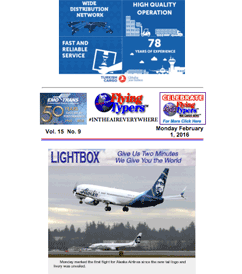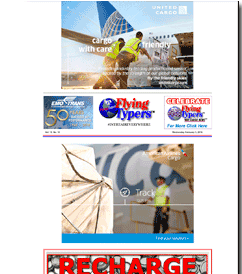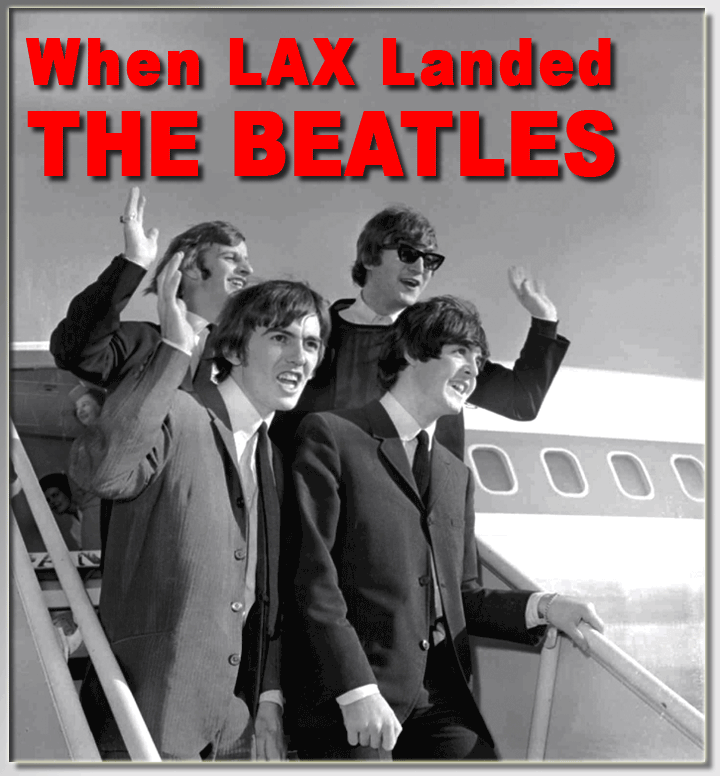
Here is a
break in the day’s occupation and an extra
special issue for all you lovers celebrating Valentine’s
Day on February 14th.
When The Beatles arrived in
Los Angeles time stood still. It’s now fifty-two
years later and our dear friend Michael Webber
is helping us remember the event.
Michael helped us celebrate
“The
Day The Beatles Landed At JFK,” which
you can celebrate all over again by clicking through.
We have added a Playlist (available
on Spotify)
and also some Beatles tunes from YouTube to add
some music to your day as you take a dip into
the deep end of the Beatlemania pool.
Go get ‘em, lovers!
Geoffrey
B-Days
July 14, 1964: More
than a month ahead of the Beatles’ anticipated
arrival at Los Angeles International Airport (LAX),
management of the Department of Airports sat down
with a local disc jockey/nightclub owner/concert
promoter, as well as representatives of local
police and fire departments to plan for two “B-Days”—internally-used
code for days on which The Beatles would be at
LAX.
The tour would open
on August 19th at San Francisco's Cow Palace,
with shows on consecutive days in Las Vegas, Seattle,
and Vancouver. The fifth date of their first full
tour of the U.S. and Canada would have The Beatles
playing the historic Hollywood Bowl on August
23rd, followed by a couple of days off before
continuing in Denver on August 26th. Therefore,
LAX management was planning for a window believed
to begin on August 23rd and end on or before August
26th.
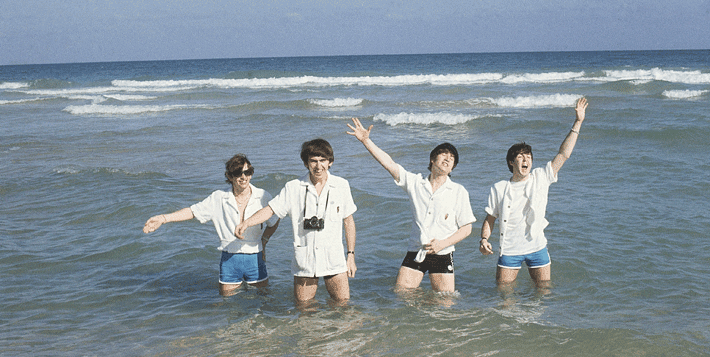 |
One
More Time?
This was not the
Beatles’ first trip to America, but it was
their first continent-wide concert tour.
A few months earlier
on February 7, 1964, the band had landed at New
York's JFK International Airport for the first
of two days of performances (split into three
broadcasts), bookending a week in which they also
played concerts in Washington, DC, and New York's
Carnegie Hall.
Two months later,
the Beatles would hold all of the top five slots
on the U.S. record charts in a single week in
April. In July, United Artists released the movie
“A Hard Days Night” to surprisingly
widespread acclaim.
The Beatles dominated
the pop music charts in unprecedented fashion,
adding cinema to their conquests. In an era when
paper concert tickets were sold in box offices
in exchange for cash, the Hollywood Bowl show
had sold out in only 3 1/2 hours— as fast
as as pre-internet sales would allow.
With the concert
sold out, the local concert promoter had no need
for additional hype and the individual Beatles
had already tired of constant hounding by fans
and media. In this context, there were no dissenters
when LAX’s airport operators resolved to
avoid the bedlam that had occurred at JFK, where
Beatles management had worked with local media
to spur a larger-than-life first impression by
leaking details of the band's airport arrival.
An
LAX Non-Event!
The objective was
to make the Beatles' presence at LAX as much of
a non-event as possible.
The first decision
documented in the airport’s own archives
was that there would be “no airport reception.”
Essentially, airport
management sought to minimize fans’ hope
that the airport might offer their best opportunity
to see the band.
With only five days
of preparation time for an entirely different
operational landscape, on August 13th airport
management was informed that the Beatles would
arrive first at LAX on its international commercial
flight to America, en route to San Francisco.
Apart from their desire to minimize the impact,
almost everything had changed from the plan refined
over the preceding month.
Pan
Am Peerless
As with their first
trip to America, the Beatles again would arrive
on a Pan Am commercial flight. The
airline had one of the most savvy marketing teams
to be found in any industry and had practically
invented the practice of “product placement”
by positioning its logo in so many iconic images
of the Beatles’ arrival at JFK. Whereas
Pan Am’s public relations and other staff
had considerable influence over the scene at JFK
near their corporate headquarters, Pan Am's influence
over planning at LAX appears to have been nominal
(although again the airline’s logo appears
omnipresent).
LAX management quickly
conferred with U.S. Public Health, Immigration
and Customs, as well as with the Federal Aviation
Agency, to plot a path for the Beatles to be processed
with minimal exposure.
Allied agencies
such as police and fire departments would have
limited roles in this particular operation, since
the Beatles would not be leaving the airport's
sterile area but would stop for less than an hour
before continuing to San Francisco.
On August 18th,
Pan Am's Boeing 707-321 departed London Heathrow
with the Beatles on board.
As was Pan Am’s
practice for each of its Clipper aircraft, this
one (registered #N728PA) had been named Peerless—even
more perfectly suiting the Beatles than February's
Clipper Defiance. As in February, Pan Am placed
a temporary sticker over the Clipper name to brand
it “Jet Clipper Beatles.”
Manitoba
Interlude
While the Beatles
would play Vancouver, Toronto and Montreal on
the Canadian dates of this North American tour,
a 25 to 35-minute refueling stop at Winnipeg would
be Manitoba's only exposure to the Beatles that
year. The locals treated the event as a proxy
for an actual concert.
Allegedly tipped
by an Air Canada employee, Winnipeg radio stations
broadcast flight details, resulting in throngs
of fans jamming the outdoor observation deck and
airfield entrances.
Impressed by the
turnout, Beatles manager Brian Epstein encouraged
the band to deplane the aircraft and acknowledge
the crowd.
 |
Decker’s
Dash
The Beatles descended
hastily gathered stairs and were immediately surrounded
by reporters who could hardly believe their good
fortune at this impromptu opportunity. Overcome
by the situation, a 17-year-old Bruce Decker made
a mad dash for the aircraft, temporarily eluding
security before being captured by Mounties almost
two-thirds of the way up the aircraft stairs.
It was just the
kind of scene airport management in LAX hoped
to prevent.
“We couldn't
see anything from the observation platform,”
Decker recalled in 1985, in what would be his
last interview, “so we sneaked down to the
ramp. It was fascinating to see the Beatles in
person here in Winnipeg. I just figured I could
make it up those steps, and I no sooner thought
of it and I was gone. I had to get a closer look
at them. The crowd roared when they saw me go.
Just as the Mounties were wrestling with me, I
caught a glimpse of the Beatles through the door
and they were chuckling. Afterwards,
kids crowded around me, touching me and screaming.
“The girls
thought there was some kind of magic about me
just because I'd got so close to them."
Guess
Who
While “Decker's
Dash” became an immortal part of Winnipeg
folklore, its namesake never had the opportunity
to meet any Beatles before passing in the 1980s.
His bandmate in a local garage band was Burton
Cummings, who would go on to fame as a member
of The Guess Who and as a solo artist who also
toured as a member of Beatle Ringo Starr’s
backing band.
Refueling completed,
the 707 was on its way to LAX. The “no reception”
mandate had already given way to plans for a press
conference on the lower level of the airport’s
Satellite 2 terminal.
The press conference
logistics had to be worked out with reporters,
as well as Pan Am and even Customs agents, in
order to preserve an ideally seamless flow of
the Beatles through the airport without exposing
the band to the public.
Best
Laid Plan At LAX
Perhaps considered
naive in hindsight, airport management still hoped
that fans could be prevented from learning of
the Beatles’ brief presence at LAX, but
by late morning, Los Angeles-area news media began
reporting that the Beatles would go through Customs
at LAX between 3:30 and 4:30 p.m. that same day.
While the media
leaks were far from ideal, LAX management relied
on the basic plan they had coordinated in recent
days with police, airport security, and other
operations personnel. All gates to the airfield
were duly manned, the stairways and elevators
leading to the satellite's lower levels were guarded,
and lobby windows surrounding Gate 20 (where the
international flight would deplane) were barricaded.
Surplus barricades were strategically stowed should
it become necessary to seal the entire satellite
area.
All
Hell Breaks Loose
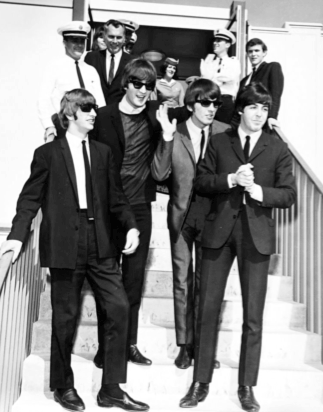 The
first of the crowd began streaming in around 1:00
p.m. By 4:00 p.m., the crowd was estimated at
about 400. An internal memo suggests that the
small crowd’s shrieks and constant motion
from window to window easily gave the impression
of an exponentially larger crowd. The
first of the crowd began streaming in around 1:00
p.m. By 4:00 p.m., the crowd was estimated at
about 400. An internal memo suggests that the
small crowd’s shrieks and constant motion
from window to window easily gave the impression
of an exponentially larger crowd.
Most were young
girls—six to sixteen—with very few
boys and no parents in sight. Having already deciphered
that a press conference was to be held, the girls
attempted to bond to the reporters and photographers
until tearfully being separated at the check-in
point from which the registered press was escorted
to the secret conference room.
At 4:15 p.m., the
707 taxied to Gate 20. This provided the only
chance for much of the public to see the Beatles
that day, descending the stairs and posing for
a few pictures.
The band acknowledged
fans visible through the windows, and although
lasting only a few seconds, this was the most
worrisome moment for airport management as hysterical
fans pounded the double-paned lobby glass.
The press conference
at LAX had been hurriedly scheduled to mark that
the Beatles had arrived in America.
Rather than the
Beatles' press manager or one of the band moderating,
reporters shouted a cacophony of questions at
multiple Beatles.
Sidebar discussions
abounded as reporters edged near the table to
question individual Beatles.
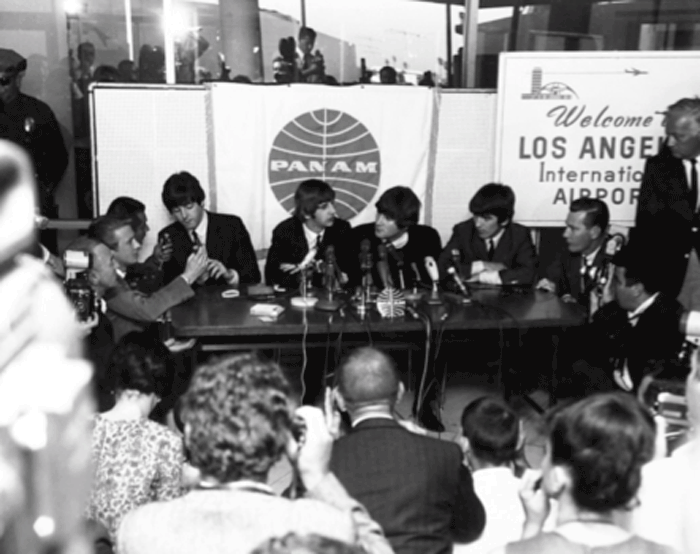 |
Other reporters
audibly protested the chaos and a visibly irritated
John Lennon appeared relieved when around the
ten-minute mark of the conference manager Brian
Epstein leaned in with a whispered message, which
Lennon enthusiastically recited as “the
Airport Authority would like for us to close this
thing down now, alright.”
Standing up and
nodding for his band mates to follow, Lennon announced
again “the airport man says we've got to
go,” adding dryly “back on the 23rd
for more photos and fun, alright.”
Contrasted with
the triumph of cheekiness and good will that characterized
the Beatles' press conference at JFK in February,
the LAX press event was a barely tolerated slog.
Signing a few autographs
as they left the conference room, the band was
led to slip aboard their 5:15 departure to San
Francisco.
An unanticipated
early B-Day lasting almost exactly an hour had
passed without injuries to the band or their fans.
The next two B-Days
at LAX should be relatively less complicated on
the airside due to being domestic flights aboard
a chartered airline that was able to deplane and
board the band without entering the terminal.
On the other hand,
those flights would introduce new potential challenges
for the airport’s landside operations, given
that the Beatles would need to leave and enter
the airport via ground transportation.
These would be the two flights for which airport
management and its allied partners had already
been planning for more than a month.
However, the planners
tweaked their plans due to lessons learned from
the first B-Day.
One such lesson
was that airport and airline employees posed potential
weaknesses in terms of leaking information to
their children.
The LAX internal
memo documents airport management’s grudging
admiration for “sharp-witted sub-teen and
teen-age girls whose grapevine communications
system antiquates the entire electronics industry”—several
decades ahead of Facebook and Twitter.
Planning
Ahead
Days ahead of the
anticipated arrival for the Hollywood Bowl show,
the Department of Airports sent a message to all
media that if LAX were too congested, the Beatles’
American Flyers chartered aircraft would be diverted
to another Southern California airport.
Generalized instructions
were telephoned to Tanner Motor Livery who was
providing ground transport for the Beatles and
their entourage, as well as to the local promoter
and representatives of the charter airline.
All 35 individuals
on the contact list were advised to be on standby
for final instructions when the arrival airport
had been confirmed.
Compared with news
of the unanticipated extra flight operation at
LAX a week earlier, the next unexpected news was
much more welcomed.
Instead of a scheduled
arrival at 3:00 p.m.—basically, rush hour
at LAX—the Beatles would leave after the
preceding show and arrive at LAX in the wee hours
of the morning. Coming from Vancouver, the flight
could either pre-clear Customs in Canada or stop
in Seattle so it would arrive in Los Angeles as
essentially a domestic flight. Doing so would
allow the aircraft to land at a remote location
known to only four people at the time, rather
than use the terminal.
Airport staff were
glad to trade a long night for having fewer fans
on-hand and more predictable ground transportation.
Essential personnel began to report at 9:00 p.m.
with the Airport Department’s Public Relations
team providing key communications and the general
manager of Operations as “field commander.”
Decoys
In Action
In an extraordinary
coincidence, Angie Macias of LAX’s P.R.
Department had previously met the Beatles and
their managers when staying in the same hotel
as the band in Copenhagen at the beginning of
their World Tour on June 4, 1964. Arriving at
midnight, airport guides Ethel Pattison and Jane
Berkey would serve as decoys in other limousines
while also directing the Beatles’ chauffeurs
to a remote airport gate.
Several key elements
of the plan fell apart quickly. The team was informed
that the flight had not pre-cleared Customs and
therefore the remote location was replaced by
the north side of Satellite 2, which was, at least,
not visible to the public. At 3:45 a.m., the Beatles
chartered Constellation arrived at the darkened
ramp to no more clamor than a handful of reporters
and airport and airline employees. A baggage tug
route was used to transport the Beatles to the
Customs clearance area.
Already known to
Beatles’ press officer Derek Taylor and
road manager Neil Aspinall, LAX’s Angie
Macias was handed the Beatles passports to marshal
through processing.
B-Day #2 at LAX
had been relatively painless. Fans had not exceeded
the hundreds and had “taken the bait”
regarding prospective alternate airports, with
several hundred also reportedly gathered at Ontario
Airport. Hours after the Beatles had left LAX,
about 150 fans remained in the Satellite 2 lobby,
refusing to believe they had already missed seeing
the band. The young girls reported they had nowhere
to go anyhow because their mothers believed they
were spending the night at friends’ houses.
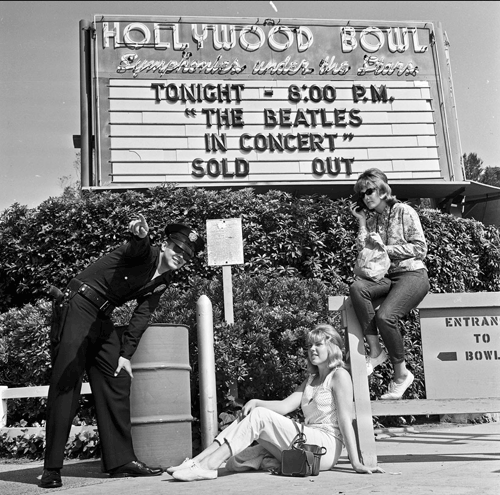 In
& Out of The Bowl In
& Out of The Bowl
After the Hollywood
Bowl concert and a couple of additional days off,
the final B-Day would be a scheduled 10:30 departure
to Denver on the morning of August 26th. With
no need for international processing, the outbound
flight could use the remote airfield location
intended to be used for the inbound flight.
Unaware of the remote
location to be used for the charter flight, the
droves of fans favored Satellite Six, where scheduled
flights to Denver frequently departed, and Satellite
Two possibly because it had been used for the
international flights.
LAX’s Angie
Macias attended the Hollywood Bowl show as the
guest of Beatles management and had been a visitor
at the Beatles’ rented Bel Air mansion.
Macias reported to the mansion for their load-out,
advising airport management when cars transporting
entourage and equipment left at 9:50 a.m., and
then rode with the Beatles in their limo departing
the mansion for LAX around 10:20 a.m.
The Beatles’
white Continental was intercepted along Pershing
Drive at the airport’s West end and then
guided by a security car through the gate direct
to the aircraft ramp. Amidst a few more photos,
the Beatles boarded the American Flyers aircraft
and at 11:04 were airborne, closing out the third
of three B-Days with the only casualties being
disappointed fans, who would have enjoyed more
access but had no enduring injuries.
To airport management,
that was the most important metric for success.
Michael Webber
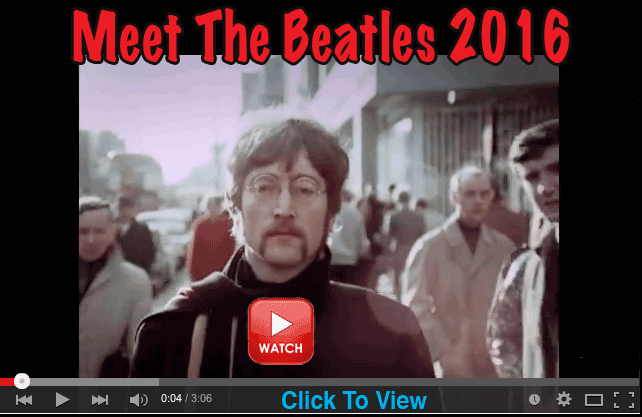 |
 (A
Postcript) Then KRLA-AM (1110) radio deejay Bob
Eubanks (better known nationally for later television
work, including hosting “The Newlywed Game”
and “Card Sharks”) mortgaged his house
to pay the Beatles $25,000 for their performance
at the Hollywood Bowl in 1964. (A
Postcript) Then KRLA-AM (1110) radio deejay Bob
Eubanks (better known nationally for later television
work, including hosting “The Newlywed Game”
and “Card Sharks”) mortgaged his house
to pay the Beatles $25,000 for their performance
at the Hollywood Bowl in 1964.
Eubanks would also
promote the Beatles’ two performances at
the Hollywood Bowl in 1965, as well as their 1966
show at Dodger Stadium.
In a recent interview,
Eubanks observed how the travel ground down the
band over the course of those years.
“They got
tired of touring. After the ‘66 tour, they
just didn't want to do that anymore.
“My personal
opinion is they were tired of being hassled and
being chased. They said, ‘OK, we're done.’”
All these years
later, Eubanks’ KRLA cohort Dave Hull was
still consistently referred to as “Dave
Hullabaloo” by sources interviewed for this
story.
Jet Clipper Peerless,
registration N728PA, was delivered to Pan Am on
March 6, 1960, and sold to International Controls
Corporation, re-registered as N11RV, on June 14,
1971.
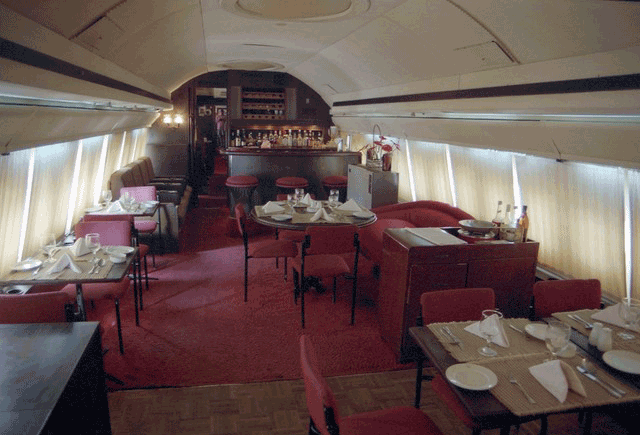 |
It
then changed hands several times before being
repossessed by Pan Am (and re-registered as N728PA)
on October 27, 1975. After several more sales,
it was sold to Air Manila International and finally
bought by an eccentric millionaire who converted
the aircraft into a stationery restaurant called
“Club 707” near the Manila airport.
Interestingly, the aircraft has an unsubstantiated
local cache for having been formerly owned by
Elvis Presley, but it never was. Alternatively,
its one-time use as Jet Clipper Beatles appears
nowhere in the promotional material. According
to the latest update found, it is fitted out as
a private jet with the original bar, desk, and
seating, but tables have been added to accommodate
up to 40 diners.
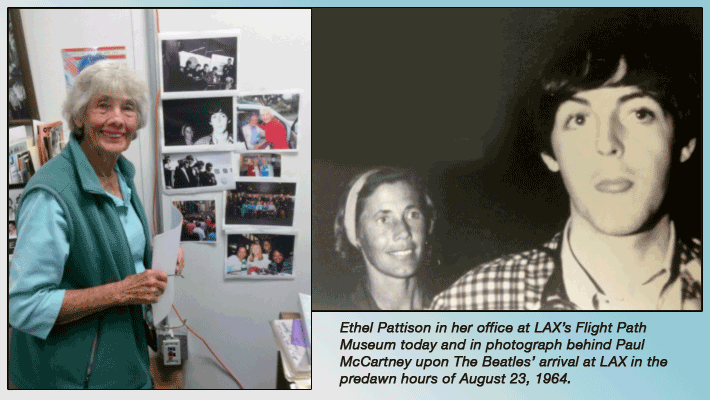
Ethel Pattison remains
active with the Flight Path Museum at LAX. The
Ethel Pattison Rose Garden was dedicated on January
25, 2006 to commemorate what was then already
50 years of service to Los Angeles World Airports.
After many years as Chief Airport Guide, her current
title is Airport Information Specialist, but many
others would as likely call her the “Heart
of LAX.” |




